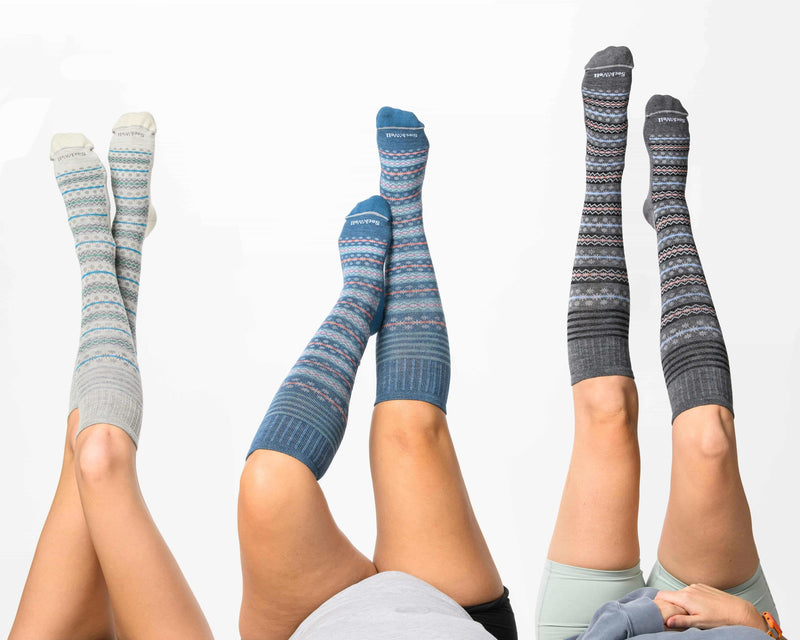
Dealing with cellulitis can be tough, but the right compression socks might be your best ally. These supportive socks can reduce swelling, boost circulation, and keep your legs feeling great. In this article, we’ll explore what makes the perfect pair and help you find the best fit for your needs. From materials to compression levels, we've got the lowdown on everything you need to know.
Key Takeaways
- Compression socks help reduce swelling, manage edema, improve circulation, relieve pain, prevent fluid buildup, and lower the risk of secondary infections in cellulitis patients.
- The best compression socks for cellulitis should provide the appropriate compression level (15-20 mmHg for mild, 20-30 mmHg for severe), have proper sizing, use breathable materials like bamboo rayon or Merino wool, and be durable for long-lasting comfort.
- Sockwell's Circulator, Elevation, and Pulse socks offer ideal support for cellulitis, with graduated compression, improved circulation, and breathable Merino wool for comfort.
- Compression socks are recommended for cellulitis and chronic edema but should be avoided in cases of severe peripheral artery disease without medical guidance.
- To manage cellulitis, consult your healthcare provider, wear socks properly, use them during waking hours, wash them gently, and combine them with treatments like leg elevation and exercises.
Understanding Cellulitis And Compression Socks
Let's dive into understanding cellulitis and how compression socks come to the rescue. It's like giving your legs a warm, snug sweater with a purpose.
What is Cellulitis?
Cellulitis isn't just a fancy term to throw around at parties. It's a pesky bacterial skin infection that paints your skin red and swells things up more than a balloon. The legs are its favorite hangout, especially if you're dealing with chronic edema or lymphedema—conditions that like to mess with your body's drainage systems.
Benefits of Compression Socks for Cellulitis
These socks are like the Swiss Army knife of legwear. They promote relief in several ways:
Reducing Swelling
Think of compression socks as the superheroes your calves have been waiting for. By applying gentle yet firm pressure, these socks help deflate the puffiness that cellulitis loves to party with. Studies show they significantly slash recurrence rates—compression socks one, cellulitis zero.
Managing Edema and Lymphatic Drainage
Got edema? Meet your new best friend. Compression socks manage the buildup by promoting proper lymphatic drainage. It's like a little nudge saying, "Hey, fluids! Move along now."
Improving Blood Flow
These socks promote circulation like nobody's business. With a gentle squeeze here and a tighter one there, blood gets the nudge it needs to dance its way up your veins, potentially lowering the risk of further complications.
Pain Relief and Discomfort Reduction
Dealing with cellulitis can feel like trying to wear shoes two sizes too small—uncomfortable. Compression socks act as a cushion that can help reduce pain and make you want to walk again.
Helping Prevent Fluid Buildup in the Legs
Picture your legs as a sponge that, when compressed, stays dry and comfy. Compression socks help keep the unwanted fluid at bay so that you can rock those skinny jeans without worries.
Prevention of Secondary Infections
Who wants a party crasher like a secondary infection? Not you. Compression socks create an environment that's less inviting for infections to crash. It’s like a bouncer for your legs, keeping the bad guys out.
Top Features In Compression Socks For Cellulitis
Choosing the right compression socks for cellulitis can feel like preparing for a fashion-forward expedition into the land of comfort and wellness. Let's unravel the threads of ideal features you want to knit into your sock selection strategy.
Compression Levels and Sizing
Compression socks work wonders with 15-20 mmHg for mild swelling or 20-30 mmHg for more serious cases. They boost circulation and keep swelling in check, which is key for managing cellulitis. Just make sure to get the right size—tight socks can be a real buzzkill, so measure those calves and get the perfect fit for all-day comfort.
Material and Breathability
Go for breathable, skin-friendly materials like Merino wool or bamboo rayon. They’ll keep your legs cool and comfy, while stretchy fabrics like nylon and spandex give you that perfect snug fit without the squeeze.
Durability and Longevity
Good socks are built to last. Look for durable pairs that can handle all your daily activities without wearing out. Quality stitching means they’ll stick with you for the long run, making your investment totally worth it!
Best Compression Socks For Cellulitis
Looking for the best compression socks to battle cellulitis? You're in for a treat! These snug wonders reduce those pesky flare-ups and make your legs feel fabulous. The secret sauce? Compression promotes blood flow and manages that oh-so-annoying edema.
Sockwell Circulator Moderate Compression Socks
The Sockwell Circulator Compression Socks are a top choice for those dealing with mild to moderate cellulitis. With a graduated compression level of 15-20 mmHg, these socks help reduce swelling, improve blood flow, and provide relief from discomfort. The soft, breathable fabric is made from a blend of Merino wool and rayon from bamboo, which helps in moisture management, keeping your feet dry and comfortable all day. Plus, the therapeutic design helps to reduce the chances of recurrence by promoting circulation and reducing leg fatigue.
Sockwell Elevation Firm Compression Socks
For those experiencing more severe swelling due to cellulitis, the Sockwell Elevation Firm Compression Socks are an excellent option. With 20-30 mmHg of graduated compression, these socks provide firm support to reduce chronic leg edema and promote healthy circulation. Made from Merino wool, these socks offer temperature regulation and odor control. The firm compression also works to prevent the pooling of fluids, which can exacerbate cellulitis, making these socks a smart choice for long-term management.
Sockwell Pulse Firm Compression Socks
The Sockwell Pulse Firm Compression Socks offer the perfect balance between function and style. With 20-30 mmHg of compression, they provide firm support to relieve leg swelling and improve circulation, making them a great choice for managing cellulitis. These socks are crafted from Merino wool, which offers natural temperature regulation and moisture management, ensuring your legs stay cool and dry even after hours of wear.
Who Should Or Shouldn't Use Compression Socks For Cellulitis
Got cellulitis? Welcome to the club—it's not exactly exclusive, but compression socks might be your easy pass to relief. For those struggling with lower limb edema, these socks will quickly become your go-to. Think of them as a mini spa treatment for your legs, promoting healing and helping prevent cellulitis from coming back. They're like personal trainers for your veins, keeping your circulation in check and giving you the support you need.
Studies have your back here. Patients sporting these fabulous stockings show a noticeable drop in cellulitis flares. There's a cool stat—only 15% of patients experienced recurrence with compression socks versus 40% without. Who doesn’t love a good statistic, right? If you're dealing with chronic edema, you're in luck. Compression socks manage that too, reducing cellulitis episodes along with the swelling.
For those who shouldn’t slip these socks on, let's spell it out. If your doctor forbids them—may be due to severe peripheral artery disease or skin infections—listen up. Medical advice is gold, so follow it religiously. For everyone else ready to embrace a softer landing, these socks offer comfort, support, and a touch of modern wizardry. Sock it to cellulitis, and let your legs breathe easier.
Tips For Using Compression Socks To Manage Cellulitis
Compression socks offer a gentle, supportive hug for your legs, promoting circulation and helping manage swelling caused by cellulitis. Here are some useful tips to get you started.
Consulting Your Healthcare Provider
Before diving feet-first into the world of compression socks, chat with your healthcare provider. They ensure you get the perfect pair with the right pressure level, especially if you have chronic leg edema or a history of cellulitis. After all, nobody wants to play sock roulette with their health!
Proper Wearing Techniques for Maximum Effectiveness
Mastering the art of putting on compression socks starts by turning the sock inside out, grabbing the heel pocket, and sliding it halfway onto your foot. Worried about getting it over your heel? Use both hands to pull it smoothly up and over your calf. Adjust the heel, smooth out any wrinkles, and position the top band just a couple of fingers below your knee—simple, right? For a visual guide, check this out.
Recommended Duration and Frequency of Wear
Once you’ve nailed the technique, you might wonder: How often do I wear these snug socks? Generally, wearing them during waking hours is effective. Yet, ensure breaks if your skin feels uncomfortable or if advised by your healthcare provider.
Caring for Compression Socks
Your trusty compression socks deserve some TLC. Handwash with mild detergent to keep them in tip-top shape. Drying flat maintains elasticity, similar to how we want to keep our spirit—unwavering yet flexible.
Pairing with Other Treatments
While compression socks do their shimmering magic, other treatments can further assist. Elevation, regular leg exercises, and good skin care complement the benefits.
Final Thoughts
Compression socks are a simple, effective way to manage cellulitis. With the right compression and fit, they enhance circulation and reduce swelling. Opt for socks made from quality materials like Merino wool or bamboo rayon, and consult your doctor for guidance. Embrace the benefits of compression socks and take proactive steps towards reducing cellulitis flares and improving your quality of life.
Fight cellulitis the easy way with Sockwell’s compression socks. Made from Merino wool, they help reduce swelling, improve blood flow, manage edema, and prevent discomfort from fluid buildup. Ready for relief? Shop now and feel the difference!



